Business
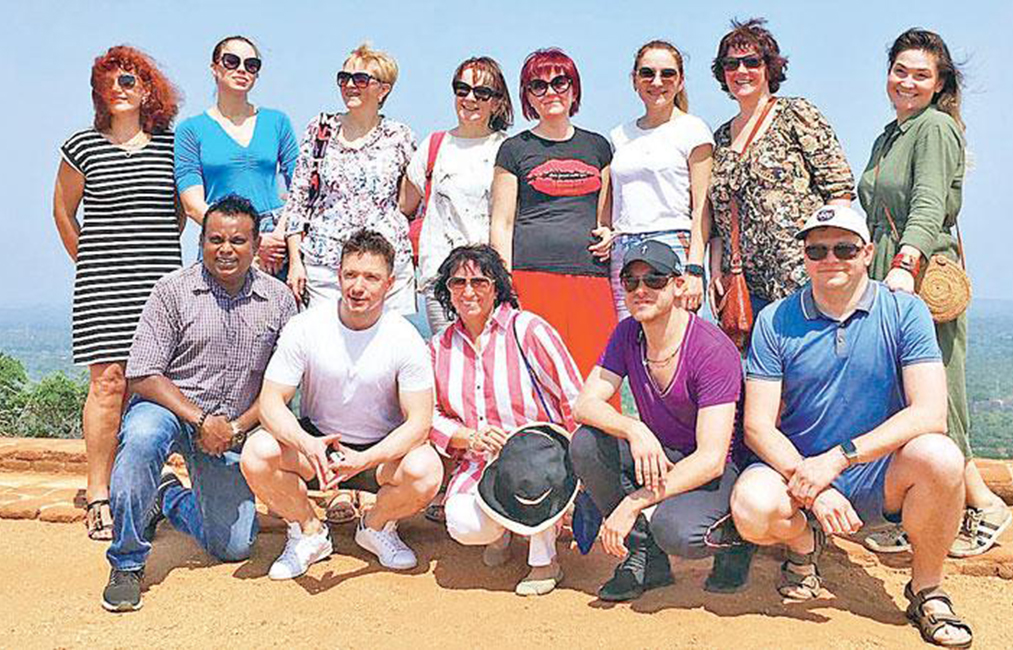
Russian tour operators visit SL
A group of 12 tour operators from St. Petersburg, Russia is currently in Sri Lanka for a familiarization tour with Aitken Spence Travels.The group leader Gorodenskiy Dmitry stated that he along with his other colleagues are very happy to be in Sri Lanka, which incidentally is their first visit although they have been promoting destination Sri Lanka.
“We are very happy about the security provided and felt everything is very normal. We love the Sri Lankan people and they are so friendly and helpful,” said Gorodenskiy.
He was confident that his Russian colleagues in the group will promote destination Sri Lanka and drive the much-needed tourists to the island.
The group visited Sigiriya and climbed the 660 ft tall rock capitol of King Kasyapa which is a UNESCO World Heritage Site. Sigiriya is considered one of the best-preserved examples of ancient urban planning.
The group would also make their way to the Dambulla cave temple, the Kandy Temple, experience a tea plantation, visit the gentle giants at the Pinnawela elephant orphanage and sum the tour by spending some time to enjoy the beach prior to departure.
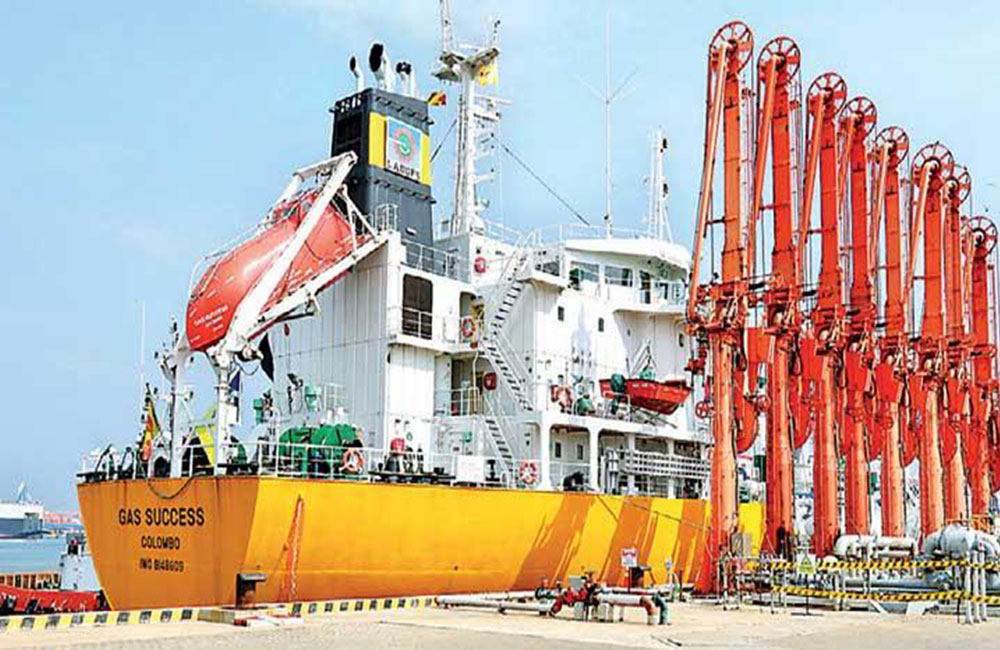
Laugfs inaugurates South Asia's largest LPG transshipment terminal
Laugfs Terminals Ltd officially inaugurated the operations of its state-of-the-art LPG transhipment terminal at the Hambantota International Port, the largest of its kind in South Asia, with the first of its LPG cargo brought in by the Sri Lankan-flagged vessel Gas Success, part of Laugfs Maritime’s own LPG vessel fleet.
The new Laugfs LPG Terminal is an important energy infrastructure in the Indian Ocean, having strategically located amidst key international maritime trading routes connecting west to east.
The first LPG cargo discharge on board Laugfs Maritime’s LPG ship, Gas Success, was ceremoniously initiated by Laugfs Chairman W.K.H.
Wegapitiya, Laugfs Group Managing Director Thilak De Silva and Hambantota National Port Group CEO Ray Ren, with the presence of Hambantota International Port Service Co. Ltd CEO Captain Ravi Jayawickrama, Laugfs Maritime Director/CEO Dr. Leslie Hemachandra, Laugfs Terminals Director/CEO Ananda Premachandra and General Manager Heshan De Silva.
“This marks a historic occasion not just for Laugfs but for our nation as well as the entire Asian region,” commented Wegapitiya.
“The first revolutionary step taken towards realising Sri Lanka’s vision to become a maritime and logistics hub in South Asia was propelled in the early 1970s by the ground-breaking initiatives taken at the Colombo Port to create a hub for container transhipment.
What we are initiating today with the Laugfs LPG transhipment terminal will be a trigger for the second such revolution in fulfilling this ambitious vision of our country by creating an energy hub surrounding the Hambantota International Port.
The economic and social impact of this to Sri Lanka is tremendous and multi-fold,” he added.
With a projected annual export value of US $ 500 million, the 30,000 MT LPG terminal represents a significant investment in infrastructure development in Sri Lanka.
The new LPG Transhipment facility will also serve to initiate coastal shipping services between Hambantota and Colombo ports for the first time in the country.
The Laugfs terminal operations are expected to create and support many direct and indirect industries surrounding its activities, generating employment and income generation opportunities for the country.
“Over the past two decades, Laugfs has been able to stride ahead with true entrepreneurial vision as a world-class Sri Lankan conglomerate that could proudly etch the Sri Lankan flag on the global map,” remarked Laugfs Group Managing Director Thilak De Silva.
Strategically located in close proximity to some of the largest emerging LPG markets and key international trading ports in the region, the Laugfs LPG transhipment terminal will garner multiple benefits to the regional LPG players, elevating its significance as a central LPG hub in South Asia.
With tremendous opportunities to support the regional growth of the LPG industry, plans are also underway for the capacity to be extended to 45,000MT by the completion of the second phase of the project, marking a total project investment of US $ 85 million.
The new Laugfs LPG terminal will operate as a central hub for LPG importing, re-exporting as well as provisioning to retailers.
The terminal is also expected to support Laugfs Gas’ rapid expansion plans in the region to become an integrated regional LPG player in the Indian Ocean Rim area by leveraging on the synergies and strengths within its energy value chain. Over the years, Laugfs’ energy presence has rapidly expanded across the region in line with the Sri Lankan government’s keen interest in the sector. Laugfs’ presence in the sector ranges from LPG downstream activities in Sri Lanka and Bangladesh by Laugfs Gas, to LPG ocean freight services and related logistics with its own fleet of LPG vessels by Laugfs Maritime and energy trading by Dubai-based SLOGAL Energy DMCC.
Laugfs has continued to build its stake in the energy value chain with strong investments in energy infrastructure and the Laugfs transshipment terminal at Hambantota will be an important addition to this journey.

Central Bank extends regulatory actions on The Finance Co.
The Monetary Board of the Central Bank of Sri Lanka (CBSL) has decided to extent by another three months from May 15, recent actions taken in connection with the troubled The Finance Company PLC (TFC).
"The Monetary Board of the Central Bank of Sri Lanka (CBSL) initiated a number of regulatory actions, as temporary measures, under the provisions of FBA, on The Finance Company PLC (TFC) with effect from 15th February 2019, with a view to safeguard the interests of the depositors and other stakeholders of the company," the CBSL said in a press release today.
Regulatory measures include suspension of accepting new deposits, withdrawal of deposits and disbursement of loans and advances to facilitate the restructuring process of TFC.
CBSL stated that the Monetary Board decided to extend the said regulatory actions in order to consider the business restructuring proposal submitted by the company and added that interest due on deposits will be paid continuously.
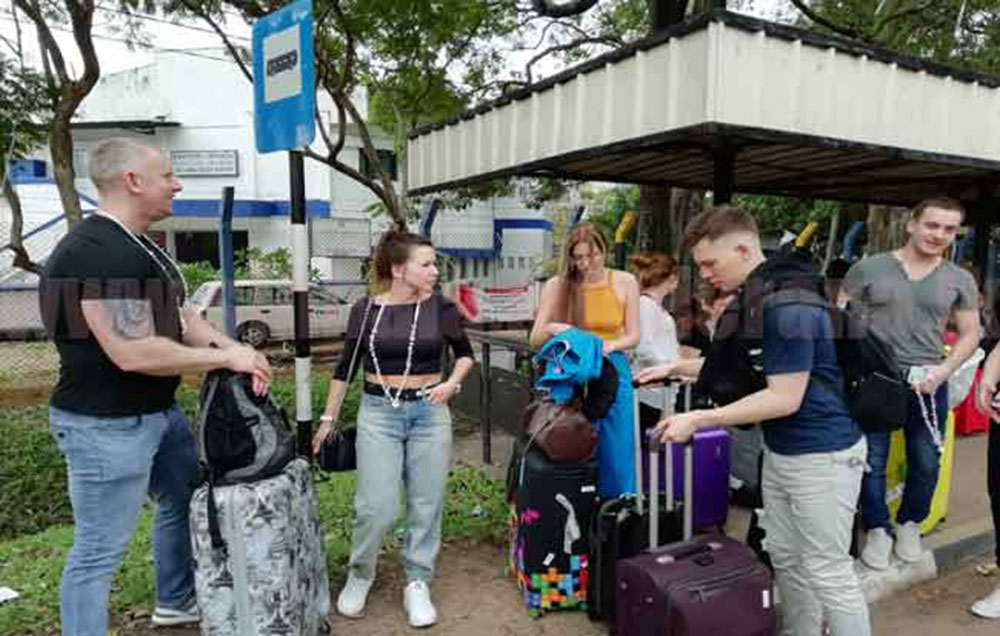
Russian tourists land in Sri Lanka; a boost to the tourism industry
At a time when the Sri Lankan tourism industry is recording a significant drop in tourist arrivals, a group comprising 52 tourists from Russia reached the Bandaranaike International Airport (BIA) on Wednesday.
The group arrived at the BIA at 8.20 am, today (05), in Russian aircraft S-6265, which arrived from Moscow, Russia.
The visitors had said that even though Russia was aware of the brutal attacks, they still wanted to visit Sri Lanka as planned while dismissing claims that the country was unsafe for travel.
The Russian tourists are expected to spend around 12 days in Sri Lanka in areas such as Weligama, Hikkaduwa and Bentota.
“We also plan to visit Sigiriya, Nuwareliya and the Ella areas as well,”, one tourist said.
The tour was organised by a private travel promotion firm in Sri Lanka.
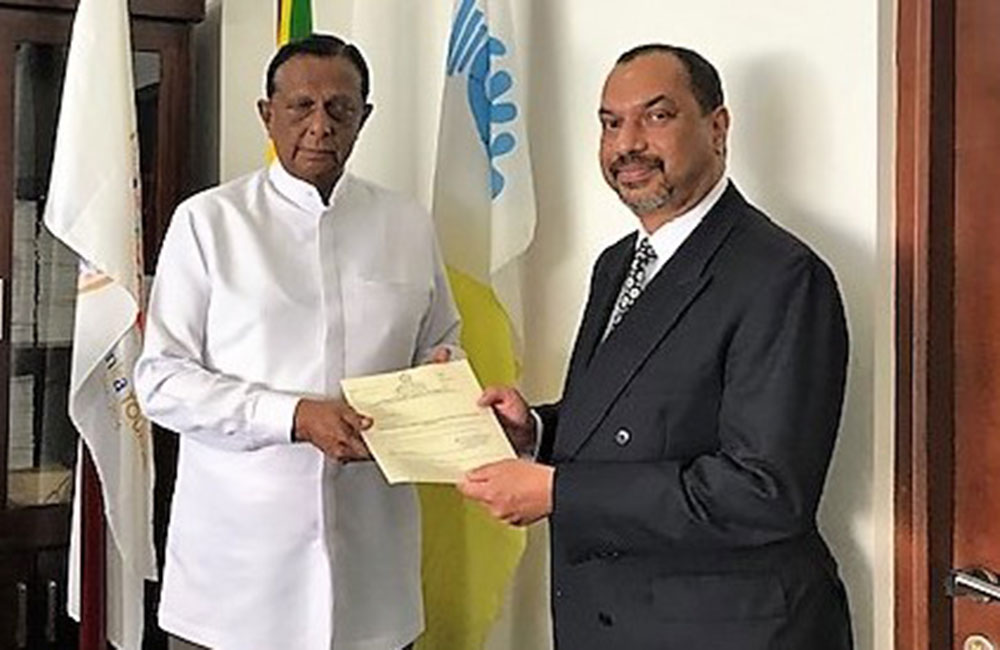
Johanne Jayaratna to lead SLTDA
Minister of Tourism John Amaratunga has appointed Johanne Jayaratne as the Chairman of the Sri Lanka Tourism Development Authority (SLTDA), today (14).
Jayaratne had been serving as Managing Director of the Sri Lanka Tourism Promotion Board (SLTPB) Prior to his appointment at the SLTDA, Jayaratna was serving as the Managing Director of the Sri Lanka Tourism Promotion Bureau (SLTPB).
Jayaratna previously served as an Executive Director of the Airport and Aviation Authority of Sri Lanka.
Jayaratna also served on the Tourism Advisory Board and was the Chairman of the AASL organising committees for the CHOGM, SAARC and IIFA conferences. During his tenure at AASL, Jayaratne actively collaborated with Sri Lanka Tourism in achieving the country’s tourism development strategies, and actively took part in promotional activities of the tourism industry.
He was immersed in tourism for several years during a brief spell at Walker Tours prior to emigrating to the USA to attend university and to obtain his pilot licenses.
He is a founding partner of a biometric company in Southern CA and led the organisation successfully as its CEO for many years. He also held a Board Director position at DCS America that provided identification solutions to public sector organisations worldwide and is the holder of international patents in biometric technologies that are used extensively at international airports worldwide.
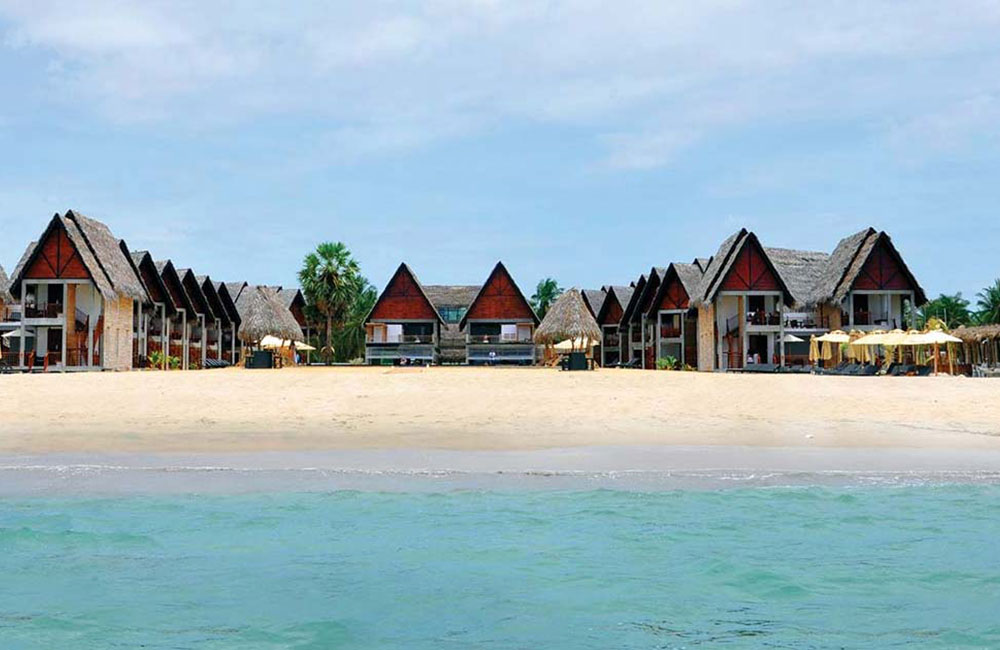
Sri Lanka resorts face uncertain future after attacks
The cancellations started before the dust had settled on the hotels and churches hit by suicide bombers in Sri Lanka as tourists and operators pressed the panic button.
Sanath Ukwatte, chairman of the colonial-era Mount Lavinia hotel in Colombo, said he lost about 30 per cent of his bookings within days of the Easter Sunday attacks that killed 253 people.
Many holidaymakers got the first plane out of Colombo after the blasts -- at least 40 foreigners were among the dead -- raising fears for a tourism industry that had managed to move on from the shadows of a decades-long civil war.
The United States, Britain, Australia, India and Israel have all warned their nationals against visiting, while the Netherlands is organising a special flight to evacuate hundreds of Dutch tourists.
On Friday, European travel giant TUI announced it had stopped taking bookings for the South Asian country.
And the crisis could get worse before it gets better for the island nation, whose palm-fringed beaches and mountain tea plantations were recently named the best place to visit in 2019 by the Lonely Planet guide.
Armed guards
Sri Lanka’s Finance Minister Mangala Samaraweera had hoped tourism would earn a record $5.0 billion this year, up from $4.4 billion in 2018. He thinks the attacks could now see the country lose up to one-third of that.
Tourism accounts for about five per cent of the economy, with Britain, India and China the main markets. Official figures show tourist arrivals in the first quarter of this year jumped 4.6 per cent to 740,600 from 2018.
But with armed guards now a fixture in some Colombo hotels and cancellations flooding in after the carnage unleashed by coordinated suicide attacks, Samaraweera must work out a rescue plan for establishments now facing ruin.
"We expect a 30 per cent drop in arrivals and that means a loss of about $1.5 billion in foreign exchange," he said on Friday.
Ruchir Desai, a senior investment analyst with Asia Frontier Capital in Hong Kong, said the next year will be a tough one for Sri Lanka.
"Given the scale of the attack I still think you would see a negative impact on the industry," Desai told AFP.
"It should recover," he added, "obviously it depends on the steps the government takes to improve stability."
Ukwatte, who is also president of the Hotels Association of Sri Lanka, hopes Sri Lanka can "bounce back".
Sri Lanka's tourism is heading into its low season, and Ukwatte believes if confidence can be restored by October or November, "then we will be able to revive the industry with European winter travellers."
Finance Minister Samaraweera highlighted how other countries hit by Islamic State-inspired attacks rebuilt their image and convinced tourists to come back.
"Typically, countries that suffer isolated IS-style attacks see tourism recovering within one-to-two years, as long as root causes are addressed and security measures taken are well communicated," the minister said.
He pointed to tourist industries in Belgium, France, Spain and Tunisia as countries which had all managed to bounce back after suffering indiscriminate terror attacks.
Bad message
Much will depend on how the government gets its message across, observers said.
Canadian adventure tourism promoter Wade Campbell criticised the government's communications after the attacks, particularly a top defence ministry official -- who has since resigned -- who said Sri Lankan hotels should have arranged their own security to avoid being hit.
Danger is "a perception thing," said Campbell, who is now looking at redirecting bookings to rival destinations like Nepal.
Italians Donatella Papi and her husband Maurizio Fantappie were on a 25-day holiday in eastern Sri Lanka when the bombers struck.
"My husband wanted to leave after the bombings, he suggested going to Thailand. But I wasn't too scared then, I thought it would settle down," said Papi.
"I think Sri Lanka tourism will fall -- we are very sad about it. This year is the anniversary of the end of the war -- it was supposed to be a celebration," she said.
"We have no regrets about staying on but we are very sad and worried -- for our safety and for Sri Lanka."

Spa Ceylon opens 90th store in Moscow
Spa Ceylon – the world’s largest Ayurveda Wellness chain, reached their landmark 90th international location with the opening of their exclusive Wellness Boutique at the prestigious Evropeiskiy Shopping Mall located in the heart of the Russian Capital - Moscow. This follows the successful opening of the brand’s 1st Russian store in the resort city of Sochi earlier this year.
Speaking to media in Moscow, Shiwantha Dias, Managing Director Spa Ceylon stated that this prestigious opening was a significant milestone for the brand. “We plan to expand rapidly in Russia & to have around 10 branded stores in operation by end 2020, at locations earmarked across Moscow & major Russian cities such as St. Petersburg, Novosibirsk, Yekaterinburg, Nizhny, Novgorod & Kazan. We have also commenced online retailing via multiple digital channels in the country, very successfully catering also to the growing Russian demand forM-commerce” said Shiwantha.
Speaking to media at the opening, co-founder director Shalin Balasuriya explained “The continued growth of the international wellness market to over US$ 4.2 trillion signals a strong shift in consumer preferences towards wellness. Spa Ceylon occupies a unique lifestyle space where personal care meets wellness. Given its brand attributes of high-performance authentic formulations, Ayurveda origins, environmental activism and ethical sourcing, it will continue to resonate with the modern consumer to drive further growth. I have spent the past few days in Moscow meeting industry professionals, media & consumers that reviewed the range & am delighted by their overall response to Spa Ceylon, from packaging to product quality & functionality, giving us confidence that the store roll-out in Russia will be a great success.”

Spa Ceylon’s rapid international growth continues in 2019 with the first quarter of the year seeing the addition of 7 international new locations, including openings in Galle Fort Sri Lanka, Kuala Lumpur Malaysia, Sochi Russia, Nagoya Japan, Bambalapitiya Sri Lanka, Shangri-La Hambantota & now Moscow Russia. Their immediate next five store openings are scheduled to be in Osaka Japan, Malé in the Maldivian capital & a second store in Sofia Bulgaria. Whilst a host of other new European openings are also being finalised across Europe, the brand envisages the opening of their landmark 100th store at a premium location in Western Europe.
Firmly entrenched in the global wellness market, Spa Ceylon was awarded the prestigious Asia’s Greatest Brands status, at the Asia’s Greatest Brands & Leaders Awards 2018, with the brand’s co-founders Shiwantha Dias & Shalin Balasuriya being honoured with Asia’s Greatest Business Leaders 2018 Awards.
The brand’s multi award winning product range was also adjudged the Best New Skincare Range 2018 for their Virgin Coconut Skin Care Range at UK’s DFNI Magazine Duty Free Selections. Their luxury Ayurveda spa service offering has also brought them international acclaim through more than 10 awards & multiple global category wins at the World Luxury Spa Awards over the past 4 years.

The Spa Ceylon Story
Founded in May 2009 by brothers Shiwantha Dias & Shalin Balasuriya, ‘Spa Ceylon’ has fast become a dynamic force in the global luxury wellness sector and has taken its Luxury Ayurveda brand to the world, with a global presence of more than 90 branded stores and spas situated in Ginza Tokyo, Osaka, Kyoto & Nagoya in Japan; Moscow & Sochi in Russia; Melbourne, Australia; Sofia, Bulgaria, Larnaca, Cyprus, Bucharest, Romania, Singapore; Seoul, South Korea; Kuala Lumpur, Malaysia; Istanbul, Turkey; Mumbai & Hyderabad in India; Karachi, Pakistan, the Maldives Islands & over 30 locations across Sri Lanka. The brand also operates in Kiev, Ukraine, across Switzerland & in the USA.
Spa Ceylon captures the romance of old Ceylon combined with ancient Ayurveda wisdom to create their range of majestic spa rituals and Royal spa formulae designed to soothe, calm and relax the body, mind and soul.
Spa Ceylon now produces over 500 all-natural Ayurveda inspired personal care, wellness, make-up & home aroma products. Their complete range comprises of prestige skin, body, bath, scalp & hair care preparations, oils, balms & potions, colour cosmetics, home aroma blends, candles, diffusers, incense, herbal infusions & gourmet teas, handmade stoneware, bath accessories & a range of tropical resort wear.

Altaaqa Global Energy Services Wins Power Projects in Sri Lanka
Altaaqa Global Energy Services, a leading global provider of integrated energy solutions, has been awarded new contracts to supply 18 MW on two sites for six months by the Ceylon Electricity Board, a statement issued by the company said.
The power plants in Mahiyanganaya and Polonnaruwa, with capacities of 10 MW and 8 MW respectively at 33 KV, are to be delivered within 30 days.
“We are honoured by the trust that the Government of Sri Lanka has put in our capabilities to rapidly deliver an effective power solution,” said James Shepherd, CEO of Altaaqa Global. “We are pleased to be an integral part of the country’s initiatives to provide reliable power to its industries and domestic users.
Shepherd said that they are confident that these power plants will create a positive impact on the quality of power supply in the country and that they look forward to further investing in the Sri Lanka’s power sector through solar and hybrid solutions.
Majid Zahid, Group President, added, “This project provides us an excellent opportunity to demonstrate our commitment to making a difference to our clients, stakeholders and greater society. A continuous and dependable supply of electricity is vital to any rapidly growing country, thus we are thrilled to be playing a vital role in the growth and development of Sri Lanka’s economy.”

CBSL pays over 10 billion to ETI depositors with no financial assistance from GoSL
The Central Bank of Sri Lanka (CBSL) would be paying the now defunct finance Company, ETI Finance Limited (ETIF) depositors a total amount in excess of Rs 10 billion without any financial contribution from the Government of Sri Lanka (GoSL), the CBSL said in a release.
A number of regulatory measures have been taken on the company from time to time which resulted in, inter alia, the directors of ETIF transferring their personal assets including EAP Broadcasting Co Ltd and Swarnamahal Jewellers Ltd, and the directors giving an undertaking to transfer additional personal assets to cover the negative net worth of the company.CBSL would like to emphasise that as a result of the regulatory actions taken since the time of identifying the issues of ETIF, the company was able to realise this amount of cash to repay the depositors by disposing theassets transferred to ETIF. Further, CBSL has also initiated several legal actions against the directors of ETIF to seize personal assets of the directors and transfer those proceeds to ETIF.
Considering the extremely vulnerable liquidity position of ETIF and its inability to repay the depositors, the Monetary Board (MB) of the Central Bank of Sri Lanka (CBSL) issued directions on 02.01.2018, restricting the operations of the company. Further, based on a proposal submitted by the company, MB gave its concurences on 21.02.2018 to dispose identified subsidiary, sub-subsidiary companies and investment properties of ETIF for a total consideration of USD 75 mn, with the view of repaying the depositors utilising the sale proceeds.
The said transaction had to beconcludedexcluding certain assets for a total consideration of USD 70 mn, which was received in 4 tranches and assets to the corresponding value were transferred to the buyers. Since the buyer did not remit the remaining USD 5 mn, ETIF has retained its subsidiary, Swarnamahal Financial Services PLC (SFSP), which was intended to be transferred for the corresponding value. ETIF and SFSP, along with CBSL, are currently considering alternative measures to revive SFSP. Since SFSP was retained by ETIF for the USD 5 mn not received, there has been no financial loss to ETIF despite the transaction being not completed in its entirety.
Based on the exchange rates at the time of receiving money through the above 4 tranches, ETIF has received over LKR 11 bn so far. These funds have been already utilised to repay 20% of the deposits and accrued interest liabilities of ETIF. The company is currently processing a further 10% repayment to the depositors.

Nikki Beach Global to set up resort and spa in Sri Lanka
Nikki Beach Hotels and Resorts will build a new luxury property in Sri Lanka, Nikki Beach Global founder Jack Penrod said.
Nikki Beach Resort & Spa Sri Lanka will be located within a new development in the area’s most pristine beach of Balapitya. Surrounded by rolling hills, beautiful back waters and rainforests, the property, which will be open year round, will consist of 200 rooms and suites with rooftop pools and a stunning 200-meter private beach.
There will also be 4 restaurants and bars on site, a Nikki Spa, Tone Gym and Nikki Beach integration into the resort pool. As the stylish new destination for experiential and holistic travel in Asia, Sri Lanka is known for its untouched nature, beautiful beaches and high level of hospitality. "In its 20th year of operation, Nikki Beach continues to evolve as markets change,” says Lucia Penrod, CEO of Nikki Beach Global.
“A year ago, we shifted our focus on reorganizing our Hotel Division and the result after one year is three new projects under construction and a deeper pipeline than we have ever had before. Our first beach resort was opened in 2010 in Koh Samui, Thailand, and after 9 years, our hotel brand is ready for take off," she added.
Nikki Beach Hotels & Resorts prides itself on providing guests with an unrivaled and distinctive luxury lifestyle experience. The properties feature cutting-edge architecture, contemporary dining, indulgent Nikki Spa services and signature beach and nightclub entertainment, creating an enhanced Nikki Beach experience.

IRCON wins USD 91 million rail contract in Sri Lanka
IRCON International Ltd., has bagged an international railway contract worth $91.27 million from Sri Lanka Railways, sources from the Ministry of Transport and Civil Aviation said.
The contract is to upgrade Northern Railway line from Maho to Omanthai in Sri Lanka. Under the contract, IRCON will the upgrade the single line broad gauge track of around 128 km in length, including associated infrastructure works, said a release. This is an item rate contract, financed through Exim Bank of India as per Indian lines of credit.

Fitch Affirms Sri Lanka's Dialog Axiata at 'AAA(lka)'; Outlook Stable
Fitch Ratings has affirmed the National Long-Term Rating of Sri Lanka-based telecoms company Dialog Axiata at ‘AAA(lka)’ with a stable outlook.
KEY RATING DRIVERS
Mobile-Market Leader: Dialog’s standalone credit profile of ‘AAA(lka)’ is underpinned by its market leadership in the growing mobile and pay-TV market segments. We believe that Dialog is in a position to gain revenue market share from smaller telcos, given its superior execution and mobile networks.
High Ratings Headroom: We believe that Dialog could receive support from its 83%-parent, Axiata Group Berhad (Axiata) of Malaysia, if its standalone credit profile were to weaken. Under Fitch’s parent-subsidiary linkage criteria, we assess the relationship between Axiata and Dialog as one of a “strong parent, weaker subsidiary and moderate linkages”. The linkages include sharing key management personnel, a common name and common creditors, which could result in reputational risk to Axiata should Dialog fail.
Solid Financial Profile: The company has a solid financial profile, with industry-leading revenue growth, a stable operating EBITDAR margin of 37%-38%, and a low Fitch-forecast 2019 FFO adjusted net leverage of around 1.0x (estimated 2018: 1.0x). We forecast revenue to grow by the high-single-digit percentage (barring any tax shocks) during 2019-2020, driven by data services revenue growth of 30%-35% (2018: 32%). Revenue and EBITDA grew by 16% and 18%, respectively, during 2018, based on preliminary financial results. We expect the government’s 2018 announcement on the removal of floor rates for voice call charges to have only a limited impact on growth.
Stable Profitability: We forecast Dialog’s operating EBITDAR margin to remain stable, as larger economies of scale in the data segment offset falling profitability in the voice and text segments. Strong data growth is supported by proliferation of smartphones; over 80% of new handsets activated on Dialog’s network are 4G-enabled. Telecom tower tax of LKR200,000 per tower (effective from January 2019) will have only a limited impact on operating EBITDAR margin given annual tax liability of around LKR400 million – about 0.4% of 2018’s revenue.
Limited FCF: We forecast limited FCF during 2019-2020 as cash flow from operations will be just sufficient to fund the large capex plan and dividend commitments. We forecast capex/revenue to be around 28%-30% to expand the 4G networks and optical fibre infrastructure during 2019-2020. Dividends are likely to be around LKR3 billion-4 billion (2018 estimate: LKR3.7 billion).
Debt-Funded M&A: Dialog’s ratings have sufficient headroom for the company to undertake a debt-funded acquisition of a smaller operator. However, any rating action would depend on the acquisition price, funding structure, and the financial and operating profile of the combined entity.
Stable Sector Outlook: Fitch’s outlook for the Sri Lankan telco sector is stable, as we expect the mean net leverage for Sri Lanka Telecom PLC (SLT, AA+(lka)/Stable) and Dialog to remain stable at around 1.4x-1.5x in 2019. We expect the sector’s cash generation to improve, driven by higher mobile and broadband data usage. This will be insufficient, however, to fund the large capex requirement, leading to negative FCF. We expect average operating EBITDAR margins to remain stable, driven by improving economies of scale in the data and home broadband segment, offsetting the negative impact of the changing revenue mix.
We believe the recently announced merger between Hutchison Telecommunications Lanka (Private) Ltd and Etisalat Lanka (Private) Ltd is likely to relieve some competitive pressures that have undermined telecom companies’ revenue and EBITDA growth in recent years. The merger is pending regulatory approval.
DERIVATION SUMMARY
Dialog’s business risk profile is stronger than that of similarly rated national peers, given its market-leading position in Sri Lanka’s mobile industry, stable cash generation, and integrated service offerings. Dialog’s financial profile is better than that of SLT, with lower 2018 FFO adjusted net leverage of 1.0x (SLT: 1.8x for 2018), a larger revenue base and a better operating EBITDAR margin. Dialog has demonstrated better market execution than SLT, with its growing market share and rising EBITDA.
Dialog has a comparable business risk profile relative to leading alcoholic-beverage manufacturer Melstacorp PLC (AAA(lka)/Stable).
Melstacorp’s subsidiary, Distilleries Company of Sri Lanka (DIST: AAA(lka)/Stable), controls 60% of Sri Lanka’s spirits production, and has maintained its market leadership due to its entrenched brand and access to a country-wide distribution network. Both Dialog and Melstacorp have shown an ability to pass on the higher taxes to consumers. However, Dialog has higher ratings headroom, given its financial profile is stronger than Melstacorp. Dialog’s 2018 FFO adjusted net leverage of 1.0x is lower than Melstacorp’s 1.9x-2.0x.
Hemas Holdings PLC (AA-(lka)/Stable) is the largest private pharmaceuticals distributor in the country, and has a presence in leisure and the fast-moving consumer goods (FMCG) sectors. Dialog has a significantly stronger business profile with its market position, larger operating scale and ability to generate a wider operating EBITDAR margin, and its ability to pass on higher taxes to consumers. Hemas’s ratings are currently constrained due to regulatory pressures in the form of price controls in its pharmaceutical business. Hemas’s FFO adjusted net leverage is likely to be similar to that of Dialog over the medium term.
KEY ASSUMPTIONS
Fitch’s Key Assumptions Within Our Rating Case for the Issuer
– High-single-digit revenue growth during 2019-2020 (2018 estimates: 16%)
– Operating EBITDAR margin to remain stable around 37%-38% during 2019-2020 (2018 estimates: 38%)
– Capex/revenue to remain high at around 28%-30% (2018 estimates: 29%)
– Dividend payout of LKR3 billion-4 billion during 2019-2020 (2018 estimate: LKR3.7 billion).
RATING SENSITIVITIES
Developments That May, Individually or Collectively, Lead to Positive Rating Action
– There is no scope for an upgrade as Dialog is at the highest rating on the Sri Lankan National Ratings scale
Developments That May, Individually or Collectively, Lead to Negative Rating Action
– FFO adjusted net leverage above 3.5x, provided there is no further strengthening of rating linkages with the parent, Axiata.
LIQUIDITY AND DEBT STRUCTURE
Solid Liquidity: Dialog had sufficient unrestricted cash balance of LKR10 billion and undrawn committed bank facilities of LKR10 billion to pay for its short-term debt maturities of about LKR5 billion as of end-2018, based on preliminary 2018 financial statements. The company has strong access to local banks, being among the largest corporates in Sri Lanka. Debt consists mainly of a USD205 million syndicated facility and LKR14 billion bank term loan.
Page 17 of 29